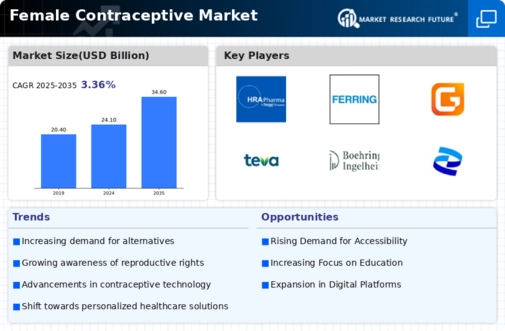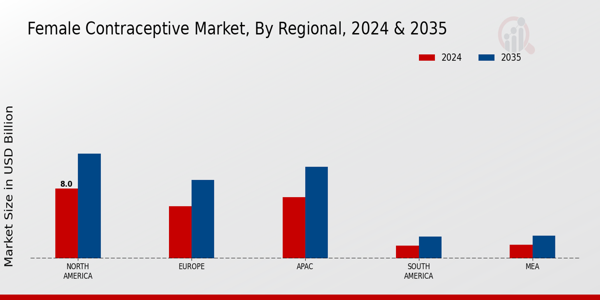Diverse Product Offerings
The availability of diverse contraceptive products is a significant driver of the Global Female Contraceptive Market Industry. Manufacturers are expanding their portfolios to include a variety of options, such as hormonal pills, intrauterine devices (IUDs), and barrier methods. This variety caters to different preferences and needs, allowing women to choose the most suitable method for their lifestyle. Additionally, the introduction of eco-friendly and non-hormonal options is gaining popularity, reflecting a shift towards sustainable practices. As the market diversifies, it is likely to attract a broader consumer base, further enhancing its growth potential.
Market Growth Projections
The Global Female Contraceptive Market Industry is projected to experience substantial growth over the coming years. With a market value of 24.1 USD Billion in 2024, the industry is expected to expand to 34.6 USD Billion by 2035. This growth trajectory indicates a compound annual growth rate (CAGR) of 3.35% from 2025 to 2035. Such projections highlight the increasing demand for contraceptive solutions and the ongoing commitment to improving reproductive health globally. The market's expansion is likely to be driven by various factors, including technological advancements, government support, and changing societal attitudes towards family planning.
Government Initiatives and Support
Government initiatives play a crucial role in the Global Female Contraceptive Market Industry by providing funding and resources for family planning programs. Many countries are implementing policies aimed at increasing access to contraceptives, particularly in underserved populations. For instance, national health programs often include subsidized contraceptive options, which can significantly reduce barriers to access. This support not only encourages the use of contraceptives but also fosters a culture of reproductive health awareness. As these initiatives expand, the market is likely to see a steady increase, contributing to an estimated market value of 34.6 USD Billion by 2035.
Cultural Shifts Towards Family Planning
Cultural shifts towards family planning are influencing the Global Female Contraceptive Market Industry. As societal norms evolve, there is a growing acceptance of contraceptive use among women of various demographics. This change is particularly evident in urban areas, where women are increasingly prioritizing career and education over early childbearing. Such shifts are supported by advocacy groups that promote reproductive rights and access to contraceptives. Consequently, this cultural transformation is expected to drive market growth, as more women seek to utilize contraceptive methods to align with their personal and professional goals.
Rising Awareness of Reproductive Health
The increasing awareness surrounding reproductive health is a pivotal driver of the Global Female Contraceptive Market Industry. Educational initiatives and public health campaigns are enhancing understanding of contraceptive options, thereby empowering women to make informed choices. For instance, various government programs promote family planning and reproductive health education, which are crucial in developing regions. This heightened awareness is expected to contribute to the market's growth, as more women seek effective contraceptive methods. As the industry evolves, it is projected that the market will reach 24.1 USD Billion in 2024, reflecting the growing demand for diverse contraceptive options.
Technological Advancements in Contraceptive Methods
Technological innovations are significantly shaping the Global Female Contraceptive Market Industry. The development of new contraceptive technologies, such as long-acting reversible contraceptives (LARCs) and digital health solutions, enhances user experience and effectiveness. For example, the introduction of mobile applications that assist in tracking menstrual cycles and contraceptive use is gaining traction. These advancements not only improve accessibility but also cater to the preferences of modern women. As a result, the market is anticipated to grow at a CAGR of 3.35% from 2025 to 2035, indicating a robust future driven by continuous innovation.














